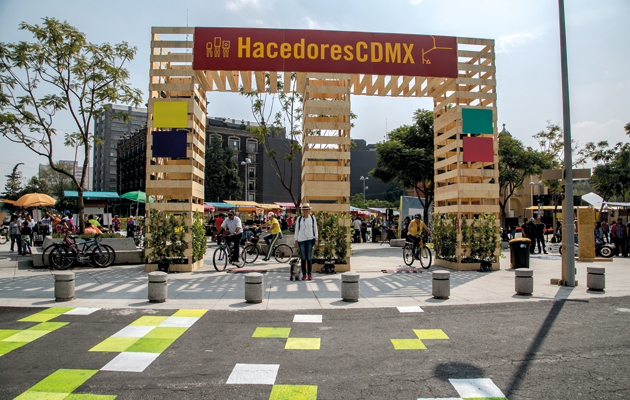|
|
||
|
In Mexico City, Gabriella Gomez-Mont’s team is reimagining the megalopolis, with the help of video-game developers, robot designers and the city’s many informal communities. Icon met her at the Future Everything conference in Manchester Shortly after entering office, Mexico City’s mayor set about establishing a government department that would inject a dose of creativity into public policy. He invited several proposals and the winning pitch came from an artist, writer and curator. Eighteen months later, Gabriella Gomez-Mont leads a team of 19 publicly employed architects, designers, geographers, historians, journalists, filmmakers and policy experts that engages in open-ended research from their rooftop office in the city centre, with a megalopolis of 22 million people as its testbed. Since its inception, Laboratorio para la Ciudad has implemented more than 40 projects, from temporary platforms for public debate and art installations that highlight social problems, to permanent interventions such as a youth centre in a pedestrian tunnel. “A lot of our work involves using existing spaces more creatively,” Yale and MIT fellow Gomez-Mont says, following her keynote speech at Manchester’s Future Everything conference earlier this year. “For example, we are working with a public kitchen to make more visible the marginalised people that congregate there, looking to see if it could be used as a community centre, for urban agriculture or to create jobs.”
People can enter the structure and share their ideas for the city with a member of the lab team The lab invites experts from various fields to work with it for extended periods – often through its connections with local and international universities. Among these was Miguel Morán, a programmer selected for a fellowship at the lab, who has devised an app to allow people to check the legitimacy of taxis, reducing the crime associated with unlicensed vehicles. The developers of the video game Minecraft conducted a workshop at the central Zócalo square as part of an inquiry into the role of children in cities. Meanwhile, AI experts are designing robots for use during earthquakes. The lab is pushing for laws that oblige the government to buy only open-source code and inviting journalists to sift through public data. Laboratorio para la Ciudad is not unique, but it is the first institution of its kind in a developing country. According to Gomez-Mont, its main aim is to bridge the gap between the state and citizens, while simultaneously functioning as a space where it’s acceptable for a government to innovate and fail. Having established a series of non-profit arts organisations, she was previously a strong advocate of working outside the establishment, so in taking on this role, she had to challenge her own view of the public sector as dysfunctional – an attitude shared by many Mexicans. “We often think of the government as lethargic and boring, but it’s also the entity that can most easily inject ideas into a city – and it’s too big an influence to ignore.” Gomez Mont’s keynote speech at Manchester’s Future Everything The lab’s very existence – and its mission to reshape social interactions through spatial interventions – has echoes of the top-down approach to urban planning that dominated during Latin America’s, and Mexico’s, modernist era. But, while Gomez-Mont acknowledges this influence, she argues that the lab’s approach draws equally on Mexico City’s vast swaths of informal development. “A lot of spaces are created outside of the general planning agenda – all over the city, for example, people open up the windows of their homes and set up stores. Government can create a scaffolding that takes into account the natural ways cities are created and the symbiotic nature of the formal and informal.”
Inside Artefacto Urbano It is this informality, she says, that makes somewhere like Mexico City suitable for an organisation designed to increase citizen participation: “What better place to experiment with the co-creation of a cityscape?” It seems that, more than physical or digital interventions, public discourse is at the heart of the laboratory’s philosophy. “Public space it not only about physical structures, but also the culture within them. By generating conversation about, say, streetlife and green transportation, we can empower citizens to protect what they value.” It is easy to be cynical of the “participation” rhetoric that has become fashionable since the turn of the century in a drive to humanise social policy. Yet, Gomez-Mont’s engagement with political issues suggests that the initiative is more than simply a bread-and-circuses approach to urban governance. She is, for example, under no illusions about the limits of her influence over the effects of globalisation on the built environment and is adamant about the importance of preserving a city’s character. “I’m a great admirer of New York, for example, but the neoliberal path is not for us. We have a strongly social agenda, so one of the first things we need to establish is a collective idea of the city, of what people are proud of – something more nuanced than marketing slogans.” |
Words Debika Ray
Above: Artefacto Urbano, a tube-like structure designed by artists Gilberto Esparza and Marcela Armas |
|
|
||
|
Hacedores CDMX, a makers’ fair organised by the laboratory |
||






















